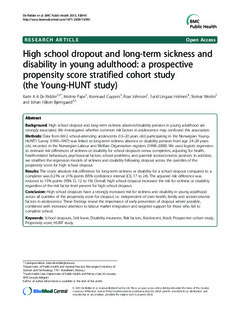| dc.contributor.author | De Ridder, Karin | |
| dc.contributor.author | Pape, Kristine | |
| dc.contributor.author | Cuypers, Koenraad | |
| dc.contributor.author | Johnsen, Roar | |
| dc.contributor.author | Holmen, Turid Lingaas | |
| dc.contributor.author | Westin, Steinar | |
| dc.contributor.author | Bjørngaard, Johan Håkon | |
| dc.date.accessioned | 2015-09-11T12:37:58Z | |
| dc.date.accessioned | 2015-09-29T13:21:10Z | |
| dc.date.available | 2015-09-11T12:37:58Z | |
| dc.date.available | 2015-09-29T13:21:10Z | |
| dc.date.issued | 2013 | |
| dc.identifier.citation | BMC Public Health 2013, 13 | nb_NO |
| dc.identifier.issn | 1471-2458 | |
| dc.identifier.uri | http://hdl.handle.net/11250/406270 | |
| dc.description.abstract | Background: High school dropout and long-term sickness absence/disability pension in young adulthood are
strongly associated. We investigated whether common risk factors in adolescence may confound this association.
Methods: Data from 6612 school-attending adolescents (13–20 years old) participating in the Norwegian Young-
HUNT1 Survey (1995–1997) was linked to long-term sickness absence or disability pension from age 24–29 years
old, recorded in the Norwegian Labour and Welfare Organisation registers (1998–2008). We used logistic regression
to estimate risk differences of sickness or disability for school dropouts versus completers, adjusting for health,
health-related behaviours, psychosocial factors, school problems, and parental socioeconomic position. In addition,
we stratified the regression models of sickness and disability following dropout across the quintiles of the
propensity score for high school dropout.
Results: The crude absolute risk difference for long-term sickness or disability for a school dropout compared to a
completer was 0.21% or 21% points (95% confidence interval (CI), 17 to 24). The adjusted risk difference was
reduced to 15% points (95% CI, 12 to 19). Overall, high school dropout increased the risk for sickness or disability
regardless of the risk factor level present for high school dropout.
Conclusion: High school dropouts have a strongly increased risk for sickness and disability in young adulthood
across all quintiles of the propensity score for dropout, i.e. independent of own health, family and socioeconomic
factors in adolescence. These findings reveal the importance of early prevention of dropout where possible,
combined with increased attention to labour market integration and targeted support for those who fail to
complete school. | nb_NO |
| dc.language.iso | eng | nb_NO |
| dc.publisher | BioMed Central | nb_NO |
| dc.title | High school dropout and long-term sickness and disability in young adulthood: a prospective propensity score stratified cohort study (the Young-HUNT study) | nb_NO |
| dc.type | Journal article | nb_NO |
| dc.type | Peer reviewed | en_GB |
| dc.date.updated | 2015-09-11T12:37:58Z | |
| dc.source.volume | 13 | nb_NO |
| dc.source.journal | BMC Public Health | nb_NO |
| dc.identifier.doi | 10.1186/1471-2458-13-941 | |
| dc.identifier.cristin | 1056313 | |
| dc.description.localcode | © 2013 De Ridder et al.; licensee BioMed Central Ltd. This is an open access article distributed under the terms of the Creative Commons Attribution License (http://creativecommons.org/licenses/by/2.0), which permits unrestricted use, distribution, and reproduction in any medium, provided the original work is properly cited. | nb_NO |
